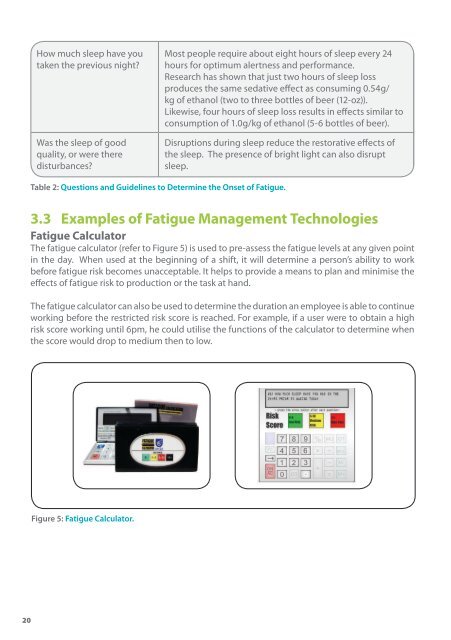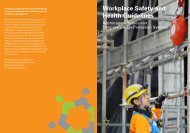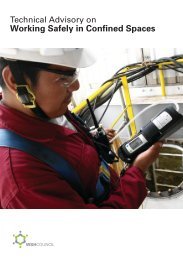Fatigue Management - Workplace Safety and Health Council
Fatigue Management - Workplace Safety and Health Council
Fatigue Management - Workplace Safety and Health Council
You also want an ePaper? Increase the reach of your titles
YUMPU automatically turns print PDFs into web optimized ePapers that Google loves.
How long have you worked<br />
without taking a break?<br />
How much sleep have you<br />
taken the previous night?<br />
Was the sleep of good<br />
quality, or were there<br />
disturbances?<br />
Working shifts that are longer than 8 or 9 hours can result<br />
in an increased probability of having accidents or making<br />
errors.<br />
Most people require about eight hours of sleep every 24<br />
hours for optimum alertness <strong>and</strong> performance.<br />
Research has shown that just two hours of sleep loss<br />
produces the same sedative effect as consuming 0.54g/<br />
kg of ethanol (two to three bottles of beer (12-oz)).<br />
Likewise, four hours of sleep loss results in effects similar to<br />
consumption of 1.0g/kg of ethanol (5-6 bottles of beer).<br />
Disruptions during sleep reduce the restorative effects of<br />
the sleep. The presence of bright light can also disrupt<br />
sleep.<br />
Table 2: Questions <strong>and</strong> Guidelines to Determine the Onset of <strong>Fatigue</strong>.<br />
3.3 Examples of <strong>Fatigue</strong> <strong>Management</strong> Technologies<br />
<strong>Fatigue</strong> Calculator<br />
The fatigue calculator (refer to Figure 5) is used to pre-assess the fatigue levels at any given point<br />
in the day. When used at the beginning of a shift, it will determine a person’s ability to work<br />
before fatigue risk becomes unacceptable. It helps to provide a means to plan <strong>and</strong> minimise the<br />
effects of fatigue risk to production or the task at h<strong>and</strong>.<br />
The fatigue calculator can also be used to determine the duration an employee is able to continue<br />
working before the restricted risk score is reached. For example, if a user were to obtain a high<br />
risk score working until 6pm, he could utilise the functions of the calculator to determine when<br />
the score would drop to medium then to low.<br />
Figure 5: <strong>Fatigue</strong> Calculator.<br />
Measures of Driver’s Eyelid Opening<br />
The driver state sensor (see Figure 6), is installed in the<br />
vehicle to measures the driver’s eyelid opening. The system<br />
uses this data to determine the presence or onset of fatigue.<br />
It also measures head orientation, providing information<br />
on distraction. Eyelid closure information is processed to<br />
determine the level of driver fatigue, <strong>and</strong> by tracking head<br />
movement, the sensor is able to detect driver’s distraction.<br />
On-board Crew Rest Facilities<br />
Long-haul flight operations can involve extra flight crew to<br />
rotate through flight deck duties when flying long hours.<br />
These aircrafts are generally equipped with on-board rest<br />
facilities to allow covering flight crew to sleep while the<br />
active flight crew are manning the flight.<br />
The Alertness Warning System<br />
The flight deck computer system is another designed-in<br />
factor. As aviation operations become highly automated,<br />
the human operator becomes passive or less active in<br />
monitoring the system. One example of using technology<br />
to address fatigue issue is an alertness warning system<br />
in some commercial aircrafts. This system alerts the<br />
flight crew when no interaction with the flight deck<br />
computers occurred within a certain time period. After a<br />
predetermined interval of no response, the signal intensity<br />
is increased automatically to initiate a response. This<br />
system is in operation on several long-haul aircrafts, <strong>and</strong><br />
flight crews have reported success in using it.<br />
Figure 6: Driver State Sensor.<br />
20 21

















